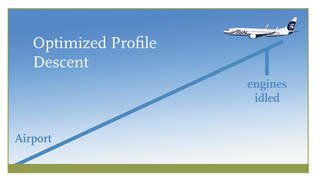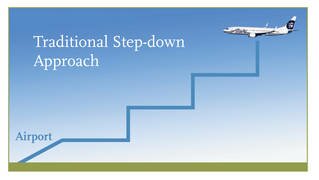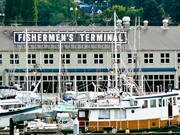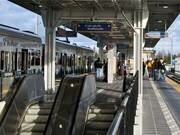To fully understand the city of Seattle's economy, character, and beauty, you sometimes have to head out on the water.
The Port of Seattle has been conducting educational tours of key Port facilities to alert community leaders and media to the importance of Seattle's maritime industry and the many issues challenging that industry.
This past Wednesday, the Port hosted Ship Canal 101, an afternoon cruise from Fishermen's Terminal to the Fremont Bridge, then to the Hiram Chittenden locks, and back to the Terminal. The tour was narrated by many of the business owners and employees of the--surprisingly--large number of businesses in this short, narrow corridor.
There's no doubt that such tours are good PR, but that aside, there's plenty to learn.
Leaving from Fisherman’s Terminal, you get a great view of the size and scope of the city's Pacific fishing fleet. For all the talk of Seattle as a biotech center, a software empire, and aviation powerhouse, a large chunk of the city's economy is still tied up to the docks at the terminal, one of the major fishing ports along the coast prized for its protected freshwater berths (salt water is murderously tough on steel hulls), access to repair facilities, and transportation to waiting markets. The Port estimates that the activity at the port annually generates 4,000 jobs, half a billion in wages, $200 million in business revenue, and $37 million in state and local taxes....
 Since last summer, Alaska Air Group has been testing out its "Greener Skies" project at Sea-Tac. This week, they made eight landing approaches in a Boeing 737-700, using Required Navigation Performance (RNP) technology to make satellite- and GPS-optimized "continuous descents."
Since last summer, Alaska Air Group has been testing out its "Greener Skies" project at Sea-Tac. This week, they made eight landing approaches in a Boeing 737-700, using Required Navigation Performance (RNP) technology to make satellite- and GPS-optimized "continuous descents."
The results, with a 737-700 weighted as if carrying passengers, were eye-opening. During descent, the 737 used 400 pounds less fuel*, and cut emissions by 35 percent. Extrapolating those results to the Alaska/Horizon fleet at Sea-Tac, that's a savings of 2.1 million gallons annually--and not releasing the 22,000 metric tons of CO2 would be like taking 4,100 cars off the road.
 How does it work? As you remember from your last trip in an airplane, descents usually involve a set of turns and stair-step drops in altitude, as the plane works its way down from cruising at about 30,000 feet. You might remember how the plane almost glided for a bit, then the engines powered up strongly as the plane advanced along the "flat" part of the stair step.
How does it work? As you remember from your last trip in an airplane, descents usually involve a set of turns and stair-step drops in altitude, as the plane works its way down from cruising at about 30,000 feet. You might remember how the plane almost glided for a bit, then the engines powered up strongly as the plane advanced along the "flat" part of the stair step.
With an optimized descent profile (ODP), the plane descends from cruising altitude as in the illustration up top, with engines working much less. Instead of tower crews relaying the descent instructions in segments, the plane's path for landing is computed and cleared all in one go. Here's the FAA's description of ODP:...
CEO Tay Yoshitani's letter in the Port of Seattle's 2009-10 annual report lays the recession's effects out for you: air travel passengers down 3 percent, shipping container volumes down 7 percent, cruise passengers down 1.2. But the Port also trimmed $16 million from its budget, and has a triple-A rating from Standard & Poor's. Given the extent of the 2009 downturn, you might have expected a lot worse.
By reducing SeaTac's operating costs, the Port was able to reduce what it charges airlines (the cost per emplanement), which gives the airlines the option of charging passengers lower fares, or not going out of business, depending on how things are going. Alaska Airlines and Horizon Air account for 48 percent of the market share at Sea-Tac, with Southwest (9 percent) and United (7) as more distant runners-up. The opening of light rail to the airport gets a tiny sidebar, where it's noted the Port saved $11 million on projected costs.
On the seaport side, to no one's surprise, China remains the top trading partner, with an 8-to1 ratio of import value to export value. That is, Chinese goods worth $16.5 billion arrived, and we sent them just over $2 billion worth. Japan, South Korea, and Taiwan trail at some distance. Singapore and Australia merit the distinction of being net importers. Top five imports are toys and sports equipment, electrical and other machinery, and knit and woven apparel. Top export: the miscellaneous grain, seed, fruit category.
On the cruise side, after adding Carnival to a mix including Holland America, Princess, and Royal Caribbean, Seattle is the sixth cruisiest port in the nation. That said, cruise volume isn't expected to increase: There were 875,000 passengers in 2009, and about 860,000 are estimated for 2010. Still quite a change from 2000, when just 120,000 people set sail....
I have seen this once, as a movie, and it was hilarious. It is possible the Port has seen the movie, too, because they're requiring a background check for their police department's Citizens Academy. But on other hand, maybe they haven't, because it's being held at Sea-Tac airport. What could go wrong there.
It's all free, but you do need to be able to commit to a once-a-week, 10-week program (Mondays, 9-11 a.m., April 12 to June 28). This is a "unique opportunity" to learn up close about the "many challenges" Port police face. I shouldn't make light of this entirely: they actually face quite a lot, including smuggling of both humans and narcotics.
Academy instructors include both police officers and civilian experts, and they go in-depth on "patrol, community policing, recruitment and training, domestic violence, narcotics, dispatch, investigations, crimes scene analysis, SWAT, explosive detection and narcotics detection K-9, and the bomb squad"--hmmm, nothing there about how to use email.
As of 10 a.m. on Saturday, December 19, there will be a SeaTac light rail station open for business. For $2.50 (one-way), you can ride the full line from the Westlake station downtown to the airport, and the Central Link segment will be complete.
It's only a three-minute jaunt from the Tukwila station, where the line used to end, to the airport station, but it cost $268 million. (The whole trip from downtown takes about 36 minutes, and trains run every 7.5 to 15 minutes, depending on the time of day.) Besides its ahead-of-schedule opening--which was originally set for December 31--the airport station has come in under budget.
The Port of Seattle handed me a fact sheet on a media preview walk-through this morning, noting proudly that the road improvements associated with the station construction cost $10 million less than budgeted in Port funds, and the pedestrian bridge and walkway came in at $1.4 million less. Altogether it's 950 feet from the platform to the first terminal skybridge, which everyone is sensitive about.
You can arrange free wheelchair service from Huntleigh (call in advance 206-433-5287), but otherwise you're hoofing it. There will be baggage carts, but nothing for you to ride on. (A people-mover was ruled out because of logistical considerations--it wouldn't really fit--and extra expense.) You won't notice the length so much on your way in; it's the return trip, when you've already hiked a few miles through airports, that the extra quarter-mile will wear on you. Still, for transit riders, a hike was already in order to get to the bus stop south of the terminal.
The Port's SeaTac employees, interestingly, may provide a good deal of the light rail regular ridership. Some 22,000 people commute to work at the airport each day, and it's hoped that some will take the new train, in addition to travelers. I'm checking with the Port on how it currently encourages its employees to take transit, and if there will be a special light rail push.
UPDATE: Perry Cooper, the Port's media officer, says via email:
We can’t predict how many employees will move to riding light rail, but we have several Commute Trip Reduction qualified employers, including the Port, Alaska Air Group, Delta and Host (who run many of our concessionaires). Another one of the largest employee groups that may take advantage of light rail are the employees of TSA, who have a significant number of employees that utilize public transportation.
For the Port’s Aviation division here at Sea-Tac, we have approximately 280 employees that hold a FlexPass, which is good on King County Metro, Pierce County Transit and Sound Transit including the Link Light Rail. We continue to promote that throughout Port employees.

Not a view from West Seattle, but still a great shot, courtesy of The SunBreak Flickr Pool member zenobia joy
The most newsworthy thing anyone can report about the eviction of Nickelsville from Terminal 107 Park, set for noon today, is the name of their new location. Rather like homelessness itself, Nickelsville resists measures like eviction.
Evicting a homeless group is like ending gun violence with a shootout. The history of Nickelsville is a history of eviction--here is West Seattle Blog coverage of a Nickelsville eviction from a year ago. Other than replacing Friday with Wednesday and updating place names, WSB could run the same story. (I say that for effect; they are covering the eviction minutely.)
The cruel irony of solving homelessness by not giving people a place to stay seems lost on the Port of Seattle and Mayor Nickels--and I should say that it's not that I'm for the appropriation of public land by any activist group that feels the whim. But I am sympathetic to the refusal of the "shelter" response....
Most Viewed Stories
- Flash! A Mob Takes Qwest Field at Half-Time
- Opinion: An Atheist's Defense of "Everybody Draw Mohammed Day"
- Why Will Smith, Joe Montana, and Wayne Gretzky Are All Coming to Issaquah Tonight
- Gather 'Round, Children, and Hear the Story of Courtney Love's Bumbershoot Secret Show
- Film Forum Spotlights Leonard Cohen, Small-Town Ohio
Top Rated Stories
- Stars, Ice, and Impossible Beauty: Backpacking in the North Cascades [Photo Gallery]
- PAX Prime 2010: Nerds In The Mist
- Allez au Cinema! Avec "The French Project"
- Wheedle's Groove's Soul Men, Interviewed at Bumbershoot 2010 [Photo Gallery]
- (Don't) Save it for Later: The English Beat's Dave Wakeling, Interviewed



Most Recent Comments